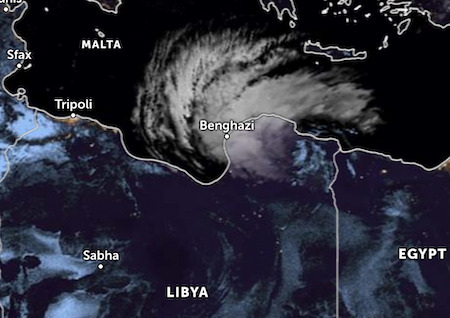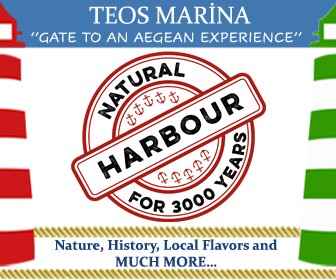Mediterranean: Medicane Phenonema Brings Disaster to Libya
Storm Daniel, which has caused torrential rainfall and flooding in Libya, was the result of a weather phenomenon called a Medicane – a Mediterranean version of a hurricane according to the World Meterological Organization.
Published 1 year ago
Extreme rainfall from Storm Daniel hit parts of the central and eastern Mediterranean in the last two weeks, causing catastrophic flooding and massive loss of life in Libya, the worst affected country, as well as in Greece, Turkey and Bulgaria.
The storm, which developed in Greece and was named by the Hellenic National Meteorological Service, developed the characteristics of a Medicane – (a MEDIterranean hurriCANE) as it moved towards Libya.
This hybrid phenomenon shows some characteristics of a tropical cyclone and others of a mid-latitude storm. Activity historically peaks between September and January. The main societal hazard posed by Medicanes is not usually from destructive winds, but through life-threatening torrential rains and flash floods.
Storm Daniel caused record-breaking rainfall in Greece on 5-6 September, with a reported 750 mm falling in 24 hours at a station in the village of Zagora.
Libya’s National Meteorological Centre said that the storm reached a peak in northeastern Libya on 10 September, with strong winds and torrential rains.


The World Meteorological Organisation said the disaster highlights the need for the international Early Warnings for All campaign launched by UN Secretary-General António Guterres. WMO is partnering with the UN Office for Disaster Risk Reduction, the International Telecommunications Union, the IFRC and a range of other partners to ensure that early warnings reach everyone and lead to early action. As the planet warms, the expectation is that we will see more extreme rainfall events, leading to more severe flooding.
“A warmer atmosphere can hold more moisture. Therefore, precipitation events – with rain, snow or hail – in a warmer climate are more intense and can lead to more flooding,” says Stefan Uhlenbrook, Director of Hydrology and Cryosphere at WMO. “More than 80% of the moisture in clouds originates from the oceans, even more in tropical cyclones. This means that increasingly warmer oceans will fuel storms further,” he says.
Sea surface temperatures above 26 °C can enhance and fuel such storms after they develop. Near the coast of Libya sea surface temperatures were above 27.5 °C, thus increasing the energy available for the convection and moisture.
Differences and Similarities
According to the WMO, Medicanes are smaller than hurricanes, with a diameter usually less than 400 km and a duration of 24 to 48 hours. But they are similar to hurricanes in that they have strong winds spinning around a core and torrential rainfall with a defined Eye which can usually be seen on satellite imagery
The most severe Medicanes can reach the strength of a Category 1 hurricane on the Saffir Simpson scale ( wind speeds of 119-153 km/h (for 1-minute maximum sustained winds)).
In September 2023, a “Medicane” named Ianos, came ashore over the Greek island of Kefalonia before moving across the mainland, causing severe flooding. The previous recorded Medicane in Greece was in 2018.
The WMO said the Libya disaster continues the series of extreme events which have caused loss of livelihoods and lives in many countries around the world in recent months.
………………………………
Related News:
- Storm Daniel leads to extreme rain and floods in the Mediterranean, heavy loss of life in Librya (WMO)
- Destruction of Derna (The Guardian)
- Libya Floods: A climate and infrastructure catastrophe (Yale Climate Connection)
- What are Medicanes? The supercharged Mediterranean storms that could become more frequent (The Guardian)
………………………………
Related Links:
- World Meterological Organization
- Hellenic National Meterological Service
- Yale Climate Connections
- Mediterranean Tropical-Like Cyclone – Wikipedia
………………………………
Find out all news, reports, links and comments posted on Noonsite, plus cruising information from around the world, by subscribing to our FREE monthly newsletter. Go to https://www.noonsite.com/newsletter/.
Related to the following Cruising Resources: Hurricanes and Tropical Cyclones, Mediterranean, Weather







